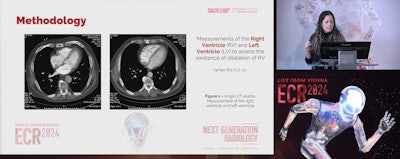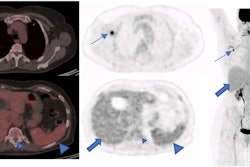Patients with COVID-19 experience a higher incidence of anatomical changes at the cardiac level on pulmonary angio-CT, suggest findings presented February 29 at ECR 2024.
In her presentation, Ana Filipa Colucas, MD, PhD, from the University of Algarve in Faro, Portugal, discussed her team’s findings, which also showed how the use of pulmonary angio-CT scans has increased since the COVID-19 pandemic.
“There were more changes in the diameter of the pulmonary artery trunk and the right ventricle in patients in the 41 to 60 years age group and in males,” Colucas said.
Previous studies suggest an association between COVID-19 and thrombosis events such as pulmonary thromboendarectomy (PTE). Pulmonary angio-CT is an established diagnostic method for patients suspected to have PTE as well as determining right ventricular dysfunction.
Colucas and colleagues identified anatomical changes in pulmonary angio-CT images and how they were tied to clinical worsening of COVID-19 and PTE. They compared results between non-COVID-19 patients and COVID-19 patients. The team wanted to understand whether the presence of COVID-19 interfered with clinical workflows at the hospital level and whether it influenced changes in cardiac anatomical structures.
 Ana Filipa Colucas, MD, PhD, presents findings at ECR 2024 on anatomical changes in COVID-19 patients as observed on pulmonary angio-CT.
Ana Filipa Colucas, MD, PhD, presents findings at ECR 2024 on anatomical changes in COVID-19 patients as observed on pulmonary angio-CT.
The researchers included data from 134 angio-CT exams from a public hospital on PTE patients. These were separated into a non-COVID patient group (n = 81) and a COVID patient group (n = 53). The researchers also obtained measurements for the right and left ventricles and the pulmonary artery trunk to evaluate right ventricle dilatation.
The team found that pulmonary angio-CT scans have increased by 88% since the COVID-19 pandemic, meaning an increase in positive diagnoses for PTE.
Also, 85.2% and 82.7% of the non-COVID-19 patients showed dilatation of the right ventricle and dilatation of the pulmonary artery trunk, respectively. For the COVID-19 group meanwhile, 92.5% and 96.2% of the patients showed right ventricle and pulmonary artery trunk dilatation, respectively.
“In this same group [COVID-19 group], the right ventricle diameter presented an average of 49.36 mm, and the pulmonary artery trunk diameter was 34.57 mm,” Colucas said.
Finally, the team reported that there were more changes in pulmonary artery trunk diameter in patients ages 61 to 80 years and in the right ventricle in patients ages 41 to 60 years, and these changes were always observed in male patients.
With this, Colucas said that the team verified the correlation between COVID-19 and right ventricle dilatation.
However, she also noted that it is difficult to identify whether non-COVID patients had previous infections and that future studies with larger sample sizes are needed to evaluate changes in anatomical structures.
For more coverage from ECR 2024, please visit our RADCast.




















